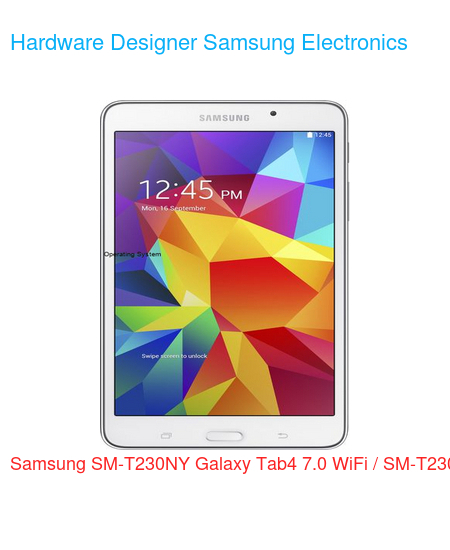| Brand | Samsung |
| Model | SM-T230NY Galaxy Tab4 7.0 WiFi / SM-T230NU |
| Released | 2015 Feb |
| Hardware Designer | Samsung Electronics |
| Manufacturer | Samsung Electronics |
| Codename | Samsung Degas |
| Device Category | Tablet |
| Width | 107.9 mm |
| Height | 186.9 mm |
| Depth | 9 mm |
| Dimensions | 4.25×7.36×0.35 inches |
| Mass | 276 g |
| Platform | Android |
| Operating System | Google Android 4.4.2 (KitKat) |
| CPU Clock | 1183 MHz |
| RAM Type | LPDDR2 SDRAM |
| RAM Capacity (converted) | 1.5 GiB RAM |
| Non-volatile Memory Interface | Yes |
| Non-volatile Memory Capacity (converted) | 8 GB ROM |
| Display Diagonal | 177.7 mm |
| Resolution | 800×1280 |
| Horizontal Full Bezel Width | 13.72 mm |
| Display Area Utilization | 70.4% |
| Pixel Density | 216 PPI |
| Display Type | Color TN-TFT LCD display |
| Number of Display Scales | 16.8M |
| Scratch Resistant Screen | No |
| Graphical Controller | Vivante GC1000 |
| A/V Out | No |
| Microphone(s) | Yes |
| Loudspeaker(s): | Yes |
| Audio Output: | 3.5mm |
| Supported Cellular Bands | No |
| Sec. Supported Cellular Networks: | No |
| Touchscreen Type | Capacitive multi-touch screen |
| Expansion Interfaces | TransFlash , microSD , microSDHC |
| USB | USB 2.0 |
| USB Services | USB charging |
| USB Connector | USB Micro-B (Micro-USB) |
| Bluetooth | Bluetooth 4.0 |
| Wireless LAN | 802.11b , 802.11g , 802.11n |
| Wireless Services | Wi-Fi Direct |
| FM Radio Receiver | No |
| Complementary Satellite Services | Geotagging |
| Supported GLONASS protocol(s) | L1OF |
| Camera Placement | Rear |
| Camera Image Sensor | CMOS |
| Number of effective pixels | 3.1 MP camera |
| Zoom | 1.0 x optical zoom |
| Focus | No |
| Video Recording | 1280×720 pixel |
| Flash | No |
| Aux. Camera Image Sensor | No |
| Aux. 2 Camera Image Sensor | No |
| Aux. 3 Camera Image Sensor | No |
| Aux. 4 Camera Image Sensor | No |
| Secondary Camera Placement | Front |
| Secondary Camera Sensor | CMOS |
| Secondary Camera Number of pixels | 1.3 MP sec. cam |
| Secondary Video Recording | 1280×720 pixel |
| Sec. Aux. Cam. Image Sensor | No |
| Built-in compass | Yes |
| Built-in accelerometer | Yes |
| Built-in gyroscope | Yes |
| Additional sensors | L sensor |
| Protection from solid materials | Yes |
| Protection from liquids | Yes |
| Battery | Li-ion |
| Estimated Battery Life | 10.0 hours |
| Added | 2024-06-23 |
Specifications data description of this 📱Samsung SM-T230NY Galaxy Tab4 7.0 WiFi / SM-T230NU📱
Title: The Ultimate Specification Guide for Your Device 🌐📅🏋️🌈🤖🛠️🚀🔧💪🖥️🎮🗂️📷🎥🔈📡💡💎🔋🔌
Introduction:
Welcome, tech enthusiasts! Today, we’re going to dive deep into the exciting world of device specifications, covering everything from network capabilities to battery life. We’ll explore the various components that make your device tick, explain their functions, and help you better understand how to evaluate a device based on its specifications. Let’s get started! 🚀
Lineup:
Before we dive into the specifics, let’s first get familiar with the key components we’ll be discussing, each represented by a fun emoji:
🌐 NETWORK, LAUNCH📅, BODY🏋️, 🌈 DISPLAY, 🤖 OS 🛠️, 🚀 Chipset 🔧, 💪 CPU 🖥️, 🎮 GPU 💻, 🧠 MEMORY 🗂️, 📷 CAMERA 🎥, 🔈 SOUND 🎵, 📡 COMMS 📶, 💡 FEATURES 🎁, 🔋 BATTERY🔌
Now, let’s move on to the exciting part!
Design:
The device’s design is crucial for both aesthetics and ergonomics. Pay attention to factors like:
🏋️ BODY – Build materials, dimensions, and weight.
🌈 DISPLAY – Screen size, resolution, refresh rate, and panel type.
Specifications:
Here’s where the real magic happens. Let’s go through each component and discuss its importance:
🤖 OS 🛠️ – The device’s operating system determines its compatibility, user interface, and customizability. Examples include Android, iOS, Windows, and Linux.
🔥🚀 Chipset 🔧 – Acting as the ‘brain’ of the device, the chipset manages data flow between components. Key players include Qualcomm’s Snapdragon, Apple’s A-series, and Samsung’s Exynos.
💪 CPU 🖥️ – Central Processing Units handle general tasks. More cores and higher clock speeds translate into better performance.
🎮 GPU 💻 – Graphics Processing Units handle graphics-intensive tasks such as gaming and heavy multitasking. A powerful GPU is important for a smooth visual experience.
🧠 MEMORY 🗂️ – RAM ensures smooth multitasking and application performance. Larger RAM capacities translate to better multitasking capabilities.
📷 CAMERA 🎥 – Sensor quality, resolution (megapixels), and aperture impact image and video quality. Look for features such as Optical Image Stabilization (OIS) and Night Mode.
🔈 SOUND 🎵 – Codec support, sound quality, and speaker configuration can impact your device’s audio experience.
📡 COMMS 📶 – 4G, 5G, Wi-Fi 6, and Bluetooth 5.2 connectivity can impact your device’s data transfer rates and compatibility.
💡 FEATURES 🎁 – Look for unique features such as water and dust resistance (IP rating), biometric authentication (face/fingerprint), and wireless charging.
🔋 BATTERY 🔌 – Battery capacity and fast-charging capabilities determine how long your device will last between charges.
Conclusion:
Understanding device specifications can help you make an informed decision. With this knowledge, you can identify what features matter most to you and choose a device that best fulfills your needs. Don’t forget to leave a comment sharing your thoughts or any questions! 💭💬✍️














